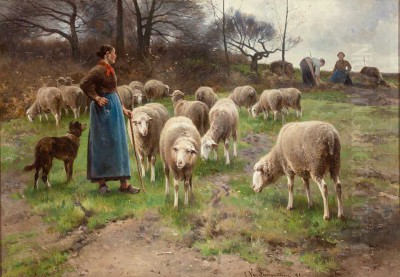
Cornelis van Leemputten stands as a significant figure in 19th-century Belgian art, celebrated for his sensitive and evocative depictions of the pastoral landscapes and agrarian life of his homeland. Active during a period of burgeoning realism and naturalism across Europe, Van Leemputten carved a niche for himself with his particular focus on farm animals, especially sheep, set within the serene countryside of regions like the Kempen. His work offers a window into a world closely tied to the rhythms of nature, rendered with a quiet dignity and a keen observational eye. Born in 1841 and passing away in 1902, his career spanned a dynamic era in art history, yet he remained steadfast in his dedication to capturing the unassuming beauty of rural Belgium.
Early Life and Artistic Beginnings
Cornelis van Leemputten was born in Werchter, a small village in Flanders, Belgium, in 1841. His initial artistic inclinations may have been nurtured within his family, as his father, Jan Frans van Leemputten, was also involved in painting. However, unlike many artists of his time who followed a rigorous academic path, Cornelis is largely considered a self-taught artist. While some sources suggest a brief period associated with the Antwerp Academy, the predominant narrative emphasizes his independent development. His family moved to Antwerp around 1852, placing the young aspiring artist closer to a major artistic center.
Despite the proximity to formal institutions, Van Leemputten's primary classroom was the outdoors. He honed his skills through direct and meticulous observation of the natural world. The landscapes near Antwerp, particularly the expansive heathlands and pastoral areas of the Kempen (Campine) region, became his principal source of inspiration. This dedication to studying nature firsthand imbued his work with a sense of authenticity and intimate understanding of his subjects, distinguishing him from artists who relied more heavily on studio conventions or idealized representations. His brother, Jean Baptiste van Leemputten, also pursued painting, suggesting a familial environment supportive of artistic endeavors.
The Development of a Naturalistic Style
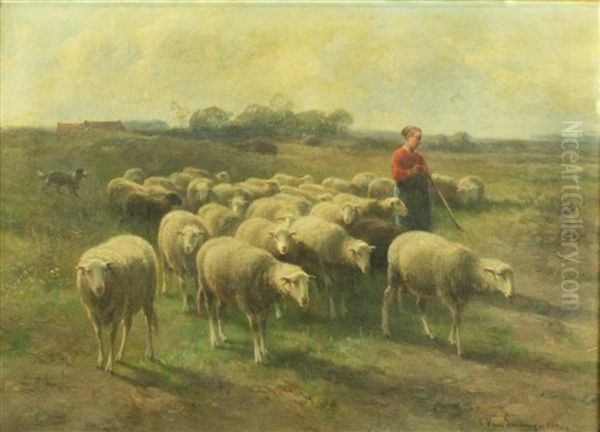
Van Leemputten's artistic style is firmly rooted in the Naturalist movement that gained prominence in the latter half of the 19th century. Naturalism, evolving from Realism championed by artists like Gustave Courbet in France, sought to depict subjects truthfully and objectively, often focusing on everyday life and the unadorned landscape. Van Leemputten embraced this ethos, concentrating on the specific textures, light, and atmosphere of the Belgian countryside. His paintings typically feature low horizons, emphasizing the vastness of the sky and the gentle roll of the land.
A defining characteristic of his work is the meticulous rendering of animals, particularly sheep. He captured their fleece, postures, and group behavior with remarkable accuracy. This focus aligns him with a tradition of animal painting, known as animalier art, which had strong roots in both the Netherlands (with masters like Paulus Potter from the Dutch Golden Age) and Belgium (with predecessors like Eugène Joseph Verboeckhoven). However, Van Leemputten's animals are rarely just anatomical studies; they are integral components of a living landscape, contributing to the overall mood of pastoral tranquility.
The influence of the French Barbizon School is palpable in Van Leemputten's approach. Artists associated with Barbizon, such as Jean-François Millet, Théodore Rousseau, and Charles-François Daubigny, advocated for painting en plein air (outdoors) and celebrated the dignity of rural labor and the beauty of the unmanicured landscape. While direct interaction isn't documented, the spirit of Barbizon clearly resonated with Van Leemputten's own inclinations.
The Influence of Charles Jacque
Among the Barbizon-associated artists, the French painter and etcher Charles Jacque (1813-1894) is most frequently cited as a direct influence on Cornelis van Leemputten. Jacque was particularly renowned for his depictions of sheep, poultry, and farm interiors, executed with a similar commitment to realism and often imbued with a rustic charm. Van Leemputten's recurring motif of sheep grazing peacefully or being guided by a shepherd echoes Jacque's popular compositions.
This influence likely stemmed from the widespread dissemination of Jacque's work, possibly through prints or exhibitions. Van Leemputten adapted Jacque's thematic focus to his specific Belgian context, capturing the unique light and landscape of Flanders and the Kempen region. While Jacque's work sometimes carried a more robust, earthy quality, Van Leemputten often favored a softer, more diffused light, creating scenes of gentle serenity. The comparison highlights how artists absorb influences while developing their own distinct voice. Other Barbizon painters like Constant Troyon, also known for his cattle and landscape scenes, contributed to the broader artistic climate that shaped Van Leemputten's direction.
Signature Themes: Sheep and the Pastoral Ideal
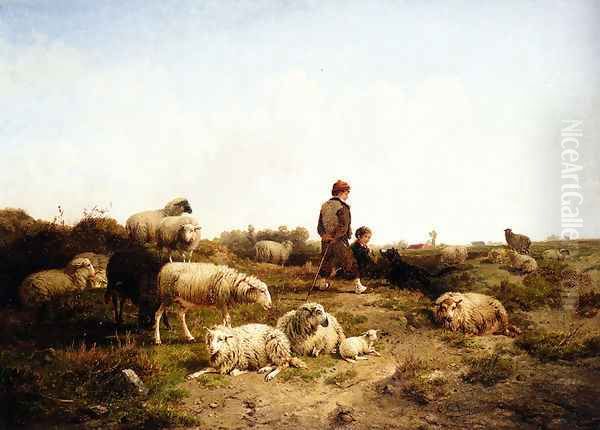
Sheep are undoubtedly the most recurrent and iconic subject in Cornelis van Leemputten's oeuvre. His dedication to this theme places him firmly within a long artistic tradition where sheep symbolize pastoral peace, innocence, and sometimes religious allegory (the shepherd and his flock). In the 19th century, depictions of sheep also resonated with a sense of nostalgia for a simpler, agrarian past that was increasingly receding due to industrialization.
Van Leemputten's paintings often depict large flocks spread across a field, sometimes under the watchful eye of a shepherd and his dog, sometimes seemingly unattended in the quiet landscape. He masterfully captured the collective movement of the flock, the individual textures of wool under varying light conditions (misty mornings, bright afternoons, approaching dusk), and the integration of the animals into their environment – grazing among sparse vegetation, resting near a small body of water, or traversing a dusty path.
Works like Flock of Sheep, Shepherd Boys With Their Flock, and A Shepherd and His Dog Guarding a Flock of Sheep exemplify this focus. The repetition of the theme was not mere duplication; it allowed Van Leemputten to explore subtle variations in light, atmosphere, and composition, demonstrating his deep familiarity and fascination with his chosen subject. His ability to convey the calm, almost meditative presence of these animals contributed significantly to the peaceful aura of his paintings.
Landscapes of the Kempen
Beyond the animals themselves, the landscape settings in Van Leemputten's work are crucial. He primarily depicted the Kempen region, an area stretching across northeastern Belgium and parts of the Netherlands. Characterized by sandy soils, heathland, marshes, and pine forests, the Kempen offered a distinct topography that Van Leemputten rendered with sensitivity. His landscapes often feature wide, open skies, low horizons, and a somewhat muted palette reflecting the specific natural light and vegetation of the area.
Unlike the dramatic mountain vistas or lush, idealized landscapes favored by earlier Romantic painters, Van Leemputten's scenes possess an understated realism. He captured the scrubby textures of the heath, the tranquil surfaces of small ponds or ditches, and the silhouettes of distant trees or humble farm buildings. Figures, when present, are usually small and integrated into the landscape, reinforcing the dominance of nature. This approach aligns with the Naturalist goal of presenting an unembellished view of the environment, finding beauty in its everyday reality. His contemporaries in Belgium, like the landscape painter Théodore Fourmois, also explored the specific character of different Belgian regions, contributing to a growing sense of national landscape identity in art.
Other Subjects: Farm Life and Interiors
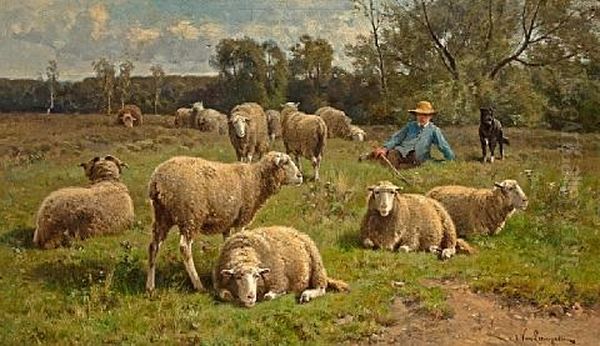
While most renowned for his sheep and open landscapes, Van Leemputten also painted other aspects of farm life. Works titled Barn Yard Scene or Barn Scene (dating suggests he revisited this theme, e.g., 1864) indicate an interest in the broader environment of the farm. These scenes might include cattle, poultry, or depictions of the farm buildings themselves. Such works allowed him to explore different textures – weathered wood, straw-covered ground, the plumage of chickens – and different light effects, such as sunlight filtering into a dim barn interior.
These paintings connect him to a genre tradition popular in the Low Countries for centuries, depicting the daily activities and settings of rural life. Belgian artists like Henri de Braekeleer, though more focused on intimate domestic interiors, shared a contemporary interest in capturing everyday environments with realistic detail. Van Leemputten's farm scenes, however, generally retain the peaceful, non-dramatic mood characteristic of his outdoor landscapes, focusing on the quiet coexistence of animals and their surroundings rather than on human labor or narrative incident. Joseph Stevens, another Belgian contemporary, gained fame for his depictions of dogs, showcasing a parallel interest in animal subjects within the Belgian art scene.
Career, Exhibitions, and Recognition
Cornelis van Leemputten achieved considerable success and recognition during his lifetime, both within Belgium and internationally. His commitment to a consistent style and subject matter found favor with collectors who appreciated the tranquil beauty and technical skill of his pastoral scenes. He participated regularly in major exhibitions, a crucial avenue for artists to gain visibility and patronage in the 19th century.
His talent was acknowledged through numerous awards at international expositions. Records indicate he received gold medals or significant recognition at Ghent (1883), Edinburgh (1886), Port Adelaide, Australia (1887), and Berlin (1896). This international acclaim underscores the broad appeal of his work, transcending national borders. The awards spanned over a decade, demonstrating sustained quality and reputation throughout the later part of his career.
Further cementing his status, Van Leemputten was honored by the Belgian state. In 1895, he was made a Knight of the Order of Leopold, one of Belgium's highest orders of merit. This official recognition signified his established position within the Belgian art world and acknowledged his contribution to the nation's cultural heritage. Such honors were significant markers of success for artists of the period.
Van Leemputten in the Context of Belgian Art
Van Leemputten's career unfolded during a rich period for Belgian art. Following its independence in 1830, Belgium experienced a resurgence in artistic activity, building on its historical legacy while engaging with contemporary European trends. Realism and Naturalism found fertile ground, with artists exploring landscape, genre scenes, portraiture, and historical subjects.
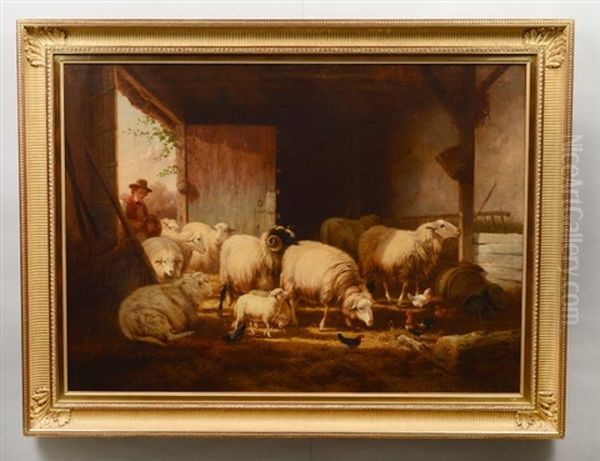
In the realm of landscape and animal painting, Van Leemputten was a prominent figure alongside artists like Alfred Verwee, who was also known for his depictions of cattle and the Flemish polders. While Verwee's style could be more robust and painterly, both artists shared a commitment to observing Belgian nature closely. The Stevens brothers, Joseph and Alfred, also achieved fame, Joseph primarily for his animal paintings (especially dogs) and Alfred for his elegant depictions of Parisian high society, showcasing the diversity within Belgian art.
Later in Van Leemputten's career, figures like Constantin Meunier emerged, bringing a focus on Social Realism with powerful depictions of industrial laborers and miners. This provides a contrast to Van Leemputten's more serene, pastoral vision, highlighting the different facets of realism being explored in Belgium. Van Leemputten remained dedicated to the rural theme, offering an alternative perspective focused on the enduring connection between land and traditional ways of life, rather than the social upheavals of industrialization. The Tervuren School, a Belgian group sometimes seen as analogous to the Barbizon School, also emphasized landscape painting, with artists like Hippolyte Boulenger.
The Self-Taught Artist: Observation as Education
One of the most frequently highlighted aspects of Van Leemputten's biography is his status as a largely self-taught artist. While he may have received rudimentary guidance from his father and possibly had brief contact with the Antwerp Academy, his primary method of learning was through direct, empirical study of nature. This path, while perhaps less conventional, was not unique in the 19th century, an era that saw increasing value placed on individual observation and a move away from strict academic formulas, partly inspired by the Romantics and solidified by the Realists and Impressionists.
His self-reliance likely contributed to the consistency and personal character of his style. Without being heavily indoctrinated into one specific academic tradition, he was free to develop his own techniques for capturing the effects of light, the textures of wool and vegetation, and the specific atmosphere of the Kempen landscapes he loved. His success, marked by international awards and state honors, serves as a testament to the power of dedicated observation and practice in achieving artistic mastery. This narrative of the self-made artist adds an element of romantic appeal to his biography, emphasizing talent and dedication over formal pedigree.
Interactions and Artistic Circles
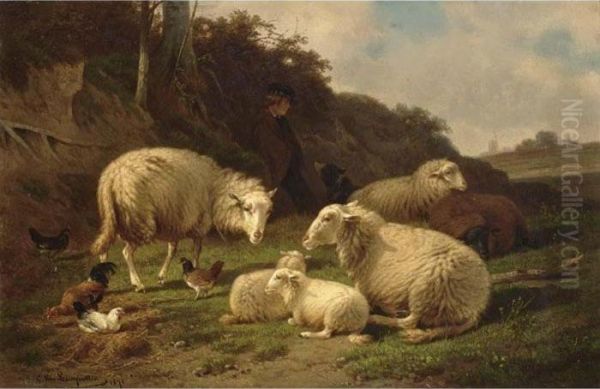
Despite his success, existing records do not provide significant detail about Cornelis van Leemputten's interactions with specific contemporary artists. While the influence of Charles Jacque is well-established stylistically, there is no evidence of direct personal contact between the two. Similarly, while he operated within the broader Belgian art scene alongside figures like Verwee or De Braekeleer, specific accounts of friendships, collaborations, or rivalries are scarce in readily available sources.
He does not appear to have been formally associated with any particular artistic group or secession movement, such as Les XX (Les Vingt), which emerged in Brussels in 1883 and championed more avant-garde styles. Van Leemputten seems to have pursued his artistic path with a degree of independence, focusing on perfecting his chosen genre rather than engaging in the theoretical debates or stylistic experiments of the modernist movements gaining traction towards the end of his career. His participation in official Salons and international exhibitions suggests engagement with the established art world structures of his time.
Legacy and Appreciation
Cornelis van Leemputten passed away in 1902 in Schaarbeek, a municipality of Brussels. He left behind a substantial body of work, primarily oil paintings, characterized by their consistent quality and thematic focus. His paintings remain popular among collectors of 19th-century European art, appreciated for their technical skill, peaceful atmosphere, and charming depictions of rural life. Museums in Belgium, such as the Royal Museums of Fine Arts in Brussels and Antwerp, hold examples of his work, ensuring its place within the narrative of Belgian art history.
His legacy lies in his mastery of the pastoral genre and his sensitive portrayal of the Belgian landscape and its animal inhabitants. He captured a specific aspect of 19th-century life and environment with sincerity and dedication. While perhaps not a radical innovator in the vein of the Impressionists or Post-Impressionists who were his contemporaries (like Claude Monet or Vincent van Gogh, whose explorations of light and color took very different paths), Van Leemputten excelled within the Naturalist tradition. He provided a comforting, enduring vision of rural tranquility that resonated with audiences of his time and continues to find appreciation today. His work stands as a quiet testament to the beauty found in the everyday observation of nature. Artists of the later Hague School in the Netherlands, such as Willem Maris, known for his luminous paintings of cattle near water, explored similar themes, showing the continued appeal of pastoral naturalism across borders. Van Leemputten remains a respected exponent of this tradition within Belgium.